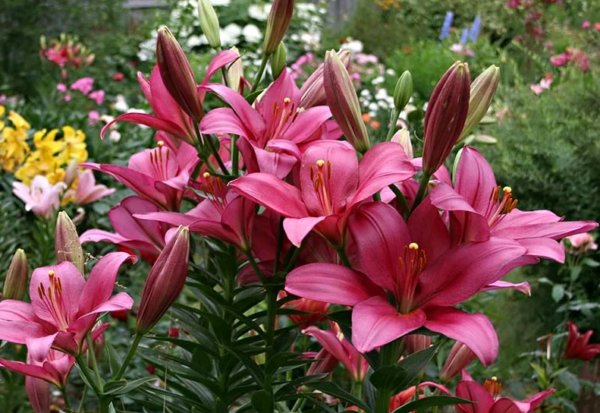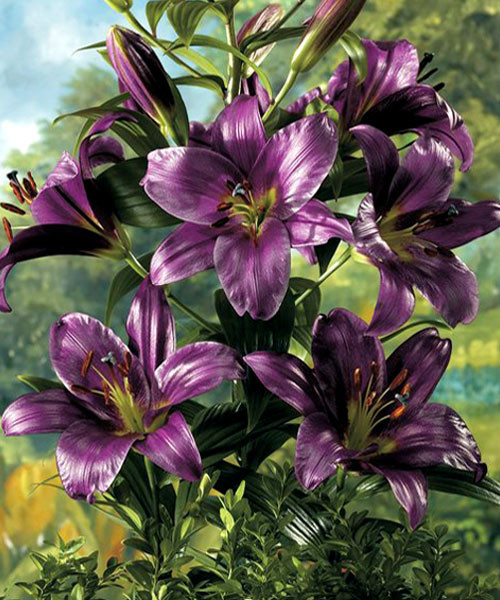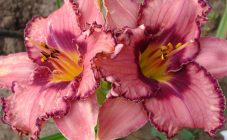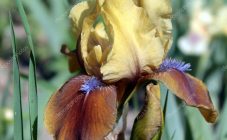Content:
People are divided into 2 types: loving lilies and very loving ones. With the colors themselves, the situation is more complicated. Their diversity is in 9 groups, several thousand varieties. Types of lilies (more precisely, groups) are determined according to the international classification proposed by J. de Graaf, an American lily grower in 1964.
Species diversity
Of more than 100 varieties of lilies, only 16 are considered adapted to the climatic conditions of Russia. Of these, gardeners are interested in:
- Henry lily with luminous orange petals;
- tiger lily with a pyramidal inflorescence similar to the skin of a tiger;
- daurian lily;
- locust - curly lily (marchagon).
All varieties and hybrids are divided into 9 groups:
- asian;
- curly (marchagon);
- snow-white (candidum);
- American;
- long-flowered;
- tubular (Orleans);
- oriental (oriental);
- interspecific hybrids;
- wild lilies.
Each group consists of varieties, hybrids obtained by selection, similar in terms of growing conditions.
Asian lilies - leaders in unpretentiousness - originate from the unusually hardy Daurian, tiger. Among them there are bulbous lilies, as well as those devoid of aroma.
Curly lilies (martagons) are distinguished by curling petals, an abundance of dark spots at the base of the petals, and a light aroma. Martagons tolerate cold well and are resistant to diseases.
Candidum are snow-white lilies that are a little capricious, prone to fungal attack. They are considered the most beautiful, pleasant aroma adds to their charm.
American lilies are bright bicolor exotic plants with a delicate aroma. They love warmth, light.
Longiflorum lilies (longiflorum) have elongated flower corollas with a predominant white or light color. Perfect for bouquets.
Oriental lilies are gentle creatures with all possible flower shapes and colors. Flower heads are huge up to 25 cm in diameter.
Interspecific hybrids are diverse in flower shape, petal color, and the level of whimsy. Legend:
- LA - a hybrid of long-flowered and Asiatic lilies;
- OT - a mixture of eastern and tubular;
- LO - longiflorums crossed with orientalochki;
- OA is a new branch of East Asian hybrids that has inherited all the virtues of its parents, except for the size of the flowers.
There are also complex hybrids obtained by crossing 3 or more species.
Wild (species) lilies live on all continents, including varieties of wild lilies growing naturally in the Russian Federation. We are talking about mountain lilies (tiger, Daurian), field lilies (saranka), forest lilies.
How Asian hybrids differ from oriental
The Asian group and the oriental one are bred on the basis of oriental species lilies (pleasant, drooping, David, Daurian, tiger - the progenitors of all hybrids). Despite common relatives, Asian and Oriental lilies have significant differences:
- "Asians" show miracles of unpretentiousness, and the Eastern ones are capricious and demanding;
- Asiatic lilies winter well in a continental climate, and oriental beauties need special training;
- before all, it is the Asian ones that begin to bloom;
- the aroma of "Asian women" is almost imperceptible to the human nose, oriental women exude a pleasant smell.
What are the most beautiful flowers
Beauty, uncommonness is a very subjective characteristic. However, there are varieties that lovers of lilies unanimously call "the most".
The most beautiful lilies
In the first place are peony lilies, or terry. Their petals are arranged not in 2 tiers, but in 3 or more, giving the corolla a resemblance to a peony. The best representatives:
- Isabella (Roselily Isabella) - oriental with 20-cm flowers of bright pink color with a white border around the edges of the petals;
- Aphrodite is an Asian light pink lily of rare beauty with 20-30 double flowers.
- Golden Stone's star-shaped lemon-yellow corolla is densely sprinkled with cherry-red splashes.
- Lionheart is a lily with an unusual, eye-catching color. The petals, maroon to black, have a lemon yellow beginning and ending.
- Orange lily Orange Electric is a spectacular "Asian". On the tangerine white petals, there are brushstrokes and brown specks that give the flower a surprising resemblance to cake.
From the marchons, summer residents appreciate the airy-lace beauty of the Lankongense lily of a delicate lavender color, Claude Shride of burgundy tones, Russian Morning, the Morning Sun, dark pink, like a windy dawn.
Oriental lilies are rightfully considered the most exquisitely beautiful:
- Garden Party with white petals decorated with yellow-red longitudinal stripes, a scattering of dark red specks;
- spectacular Stargazer, whose rich pink petals with crimson specks are bordered by a snow-white stripe;
- of fabulous beauty Broken Heart is a terry lily with soft pink petals.
Rarely found, but striking in its beauty is the complex hybrid Lady Alice, which has apricot-colored petals with white edges, sprinkled with dark specks, strongly curved, and the Baywatch OT hybrid is an amazing combination of pink petals with a lemon-yellow flower core.
The most unusual lilies
Marlene is an LA hybrid with beautiful, large - up to 20 cm - flowers, pale pink at the edges, gradually fading towards the center to pure white. The unusualness of lilies is random mutations, fasciations, when the bulb releases several peduncles at once. They are combined into one, obtaining a powerful stem-trunk with a hundred or more delicate flowers.
Lilies-giants, unusual in their size - cardiocrinums (from Greek - "heart lily") in their natural environment reach 5 meters in height. Externally similar to a liana, the giant lily is found in the rainforests of Southeast Asia. It blooms once in a lifetime, accumulating strength for several years to eject a powerful peduncle, and form several baby bulbs. Depending on the species, such a "tree" forms from 5 flowers in the Chinese variety to 80 in the giant. Whatever cardiocrinum you plant on the site, it will look like a tree.
In addition to the tall ones, there are varieties of small sizes, including dwarf lilies. They look the same as large ones, only the undersized lilies are scaled. The best representatives are Belem, Bazzer, Curitiba varieties.
Mystery Dream (Magic Dream) is an unusual terry lily with light green petals.
What colors are lilies
Groups of hybrids delight the eye with a variety of colors and shades. They are light and dark, monochromatic and multi-colored.Color classification as such does not exist, summer residents do it for themselves.
Red lilies:
- Black Out with deep red petals, almost black at the core;
- Canary Worf - fiery red terry;
- Claude Shride;
- The Arabian Night, whose wine-red petals seem to be showered with gold dust;
- The African Lady is a complex hybrid flower with flaming petals bordered by a creamy yellow stripe.
Yellow lilies with specks and spots:
- Jive - sunny yellow petals with spectacular red strokes, small specks;
- Golden Splendor is a tubular lily of an uncharacteristic yellow-gold color;
- The honey moon is unusually high with pure honey-yellow flowers.
Pink lilies:
- Scheherazade - OT hybrid of Dutch selection;
- Flashpoint.
There are lilies purple, lilac and lilac, red, peach and orange, scarlet, burgundy, crimson and white-pink.
Similar flowers
The world of lilies is complemented by plants that are not Liliaceae, but their botanical name is often "corrected" for the shape of the flower in favor of exquisite beauties:
- Chinese Belamkanda, Chinese lily. Some of its varieties are called Chinese orchids for their unusual color;
- Agapanthus is an African lily that forms a spherical inflorescence of small flowers of a lily-like shape;
- Nerina, spider lily, Japanese lily, the special charm of the flowers is given by very long stamens.
- Tricitris is a garden orchid often called the toad, or orchid lily.
What lilies do not exist
Climbing lily, climbing lily, ground cover - such variations can only be called marketing gimmicks, or more honestly, a trap for gullible, ignorant buyers. There are quite a few flowering plants in which the flower actually resembles a lily (see above), some of them are bulbous. But bulbous plants are not able to form a stem so flexible that it can curl.
Marketing gimmicks include a spherical lily, pyramidal, columnar, cone-shaped lily, cascading lily, tree lily. These unusual names define the Asian tall Marlene, several other hybrids that form unusual inflorescences as a result of random mutations.
Non-existent in nature include blue lilies, blue lilies. The gene responsible for this color of the petals is absent in liliaceae.
When purchasing planting material from random sellers, it is worth remembering a couple more nuances:
- there are no annual lilies, they are all perennial;
- they are all ornamental plants, the rest of their qualities (edibility, healthfulness) are of minimal importance.
Landing features
When choosing a place for regal beauties, take into account their lighting requirements:
- Asian, Oriental, tubular hybrids need a lot of light;
- curly ones are recommended to shade the root zone;
- the rest of the hybrids feel comfortable in partial shade.
Another requirement is good drainage. In no case should water stagnate in the areas where lilies are planted.
When preparing the soil for planting bulbs, take into account that they all prefer fertile land. The soil is fertilized with humus at the rate of 7 kg per 1 m², minerals are added at 100 g of 1 m².
Before planting, the corms are examined, cleaned, and disinfected. The optimal time for planting bulbs in open ground is from late summer to mid-autumn. Exceptions are exotics that do not winter in the soil.
Caring for lilies is not difficult, but requires attention.Top dressing is carried out three times per season:
- after the snow melts, fermented mullein, nitrogen fertilizers are used;
- during the formation of buds, mineral complexes with an increased potassium content are introduced;
- at the end of flowering, they are fed with superphosphate.
Sprinkle with soft warm water, preferably early in the morning. The regularity of watering is determined by the condition of the soil. Mulching with natural light materials helps to reduce the number of waterings, to minimize loosening and weeding.
Transplanted every 3-4 years, slowly growing species - every 5-6 years.
Choosing lilies for the garden, the summer resident solves a difficult task, since the variety of species, colors is dizzy, you want to plant everything at once. It is best to be guided by the existing growing conditions, the intended planting site. Based on the initial conditions, plants are selected for their decorative features.






















